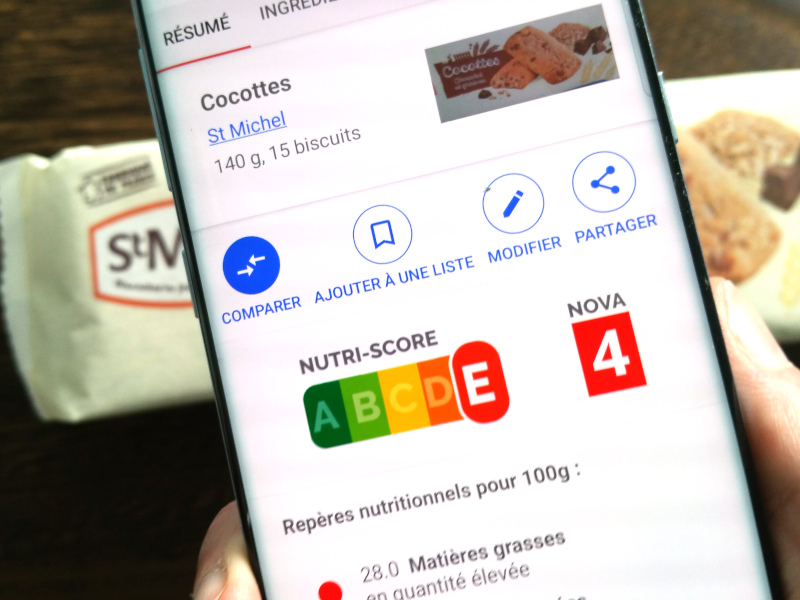Nova groups for food processing
A classification in 4 groups to highlight the degree of processing of foods
In the report "The UN Decade of Nutrition, the NOVA food classification and the trouble with ultra-processing" (pdf, pdf), Carlos Augusto Monteiro, Geoffrey Cannon, Jean-Claude Moubarac, Renata Bertazzi Levy, Maria Laura C. Louzada and Patrícia Constante Jaime advocate for the adoption of a system of grades from 1 to 4 to allow to simply compare the degree of processing of products.
New research associating researchers from Inserm, Inra and the Paris 13 University (Centre de recherche épidémiologie et statistique Sorbonne Paris Cité, équipe EREN) suggest a correlation between the cosumption of ultra-transformed foods and an increased risk of developing a cancer.
Consumption of ultra-processed foods and cancer risk: results from NutriNet-Santé prospective cohortPress Release in French : Consommation d’aliments ultra-transformés et risque de cancer
Some countries use the NOVA groups for their dietary guidelines or goals, for instance:
- Brazil's dietary guidelines recommend to limit consumption of processed food and avoid ultra-processed food.
- France's public health nutritional policy goals for 2018-2022 aims to reduce consumption of group 4 ultra-processed foods by 20%.




- Group 1 - Unprocessed or minimally processed foods
- Group 2 - Processed culinary ingredients
- Group 3 - Processed foods
- Group 4 - Ultra-processed food and drink products
Group 1. Unprocessed or minimally processed foods
Unprocessed (or natural) foods are edible parts of plants (seeds, fruits, leaves, stems, roots) or of animals (muscle, offal, eggs, milk), and also fungi, algae and water, after separation from nature.
Minimally processed foods are natural foods altered by processes that include removal of inedible or unwanted parts, and drying, crushing, grinding, fractioning, filtering, roasting, boiling, non-alcoholic fermentation, pasteurization, refrigeration, chilling, freezing, placing in containers and vacuum-packaging. These processes are designed to preserve natural foods, to make them suitable for storage, or to make them safe or edible or more pleasant to consume. Many unprocessed or minimally processed foods are prepared and cooked at home or in restaurant kitchens in combination with processed culinary ingredients as dishes or meals.
Group 2. Processed culinary ingredients
Processed culinary ingredients, such as oils, butter, sugar and salt, are substances derived from Group 1 foods or from nature by processes that include pressing, refining, grinding, milling and drying. The purpose of such processes is to make durable products that are suitable for use in home and restaurant kitchens to prepare, season and cook Group 1 foods and to make with them varied and enjoyable hand-made dishes and meals, such as stews, soups and broths, salads, breads, preserves, drinks and desserts. They are not meant to be consumed by themselves, and are normally used in combination with Group 1 foods to make freshly prepared drinks, dishes and meals.
Group 3. Processed foods
Processed foods, such as bottled vegetables, canned fish, fruits in syrup, cheeses and freshly made breads, are made essentially by adding salt, oil, sugar or other substances from Group 2 to Group 1 foods.
Processes include various preservation or cooking methods, and, in the case of breads and cheese, non-alcoholic fermentation. Most processed foods have two or three ingredients, and are recognizable as modified versions of Group 1 foods. They are edible by themselves or, more usually, in combination with other foods. The purpose of processing here is to increase the durability of Group 1 foods, or to modify or enhance their sensory qualities.
Group 4. Ultra-processed foods
Ultra-processed foods, such as soft drinks, sweet or savoury packaged snacks, reconstituted meat products and pre-prepared frozen dishes, are not modified foods but formulations made mostly or entirely from substances derived from foods and additives, with little if any intact Group 1 food.
Ingredients of these formulations usually include those also used in processed foods, such as sugars, oils, fats or salt. But ultra-processed products also include other sources of energy and nutrients not normally used in culinary preparations. Some of these are directly extracted from foods, such as casein, lactose, whey and gluten.
Many are derived from further processing of food constituents, such as hydrogenated or interesterified oils, hydrolysed proteins, soya protein isolate, maltodextrin, invert sugar and high-fructose corn syrup.
Additives in ultra-processed foods include some also used in processed foods, such as preservatives, antioxidants and stabilizers. Classes of additives found only in ultra-processed products include those used to imitate or enhance the sensory qualities of foods or to disguise unpalatable aspects of the final product. These additives include dyes and other colours, colour stabilizers; flavours, flavour enhancers, non-sugar sweeteners; and processing aids such as carbonating, firming, bulking and anti-bulking, de-foaming, anti-caking and glazing agents, emulsifiers, sequestrants and humectants.
A multitude of sequences of processes is used to combine the usually many ingredients and to create the final product (hence 'ultra-processed'). The processes include several with no domestic equivalents, such as hydrogenation and hydrolysation, extrusion and moulding, and pre-processing for frying.
The overall purpose of ultra-processing is to create branded, convenient (durable, ready to consume), attractive (hyper-palatable) and highly profitable (low-cost ingredients) food products designed to displace all other food groups. Ultra-processed food products are usually packaged attractively and marketed intensively.

Get the NOVA group with the Open Food Facts app!
Install the Open Food Facts mobile app
To scan food products, get the NOVA group for ultra-processed foods, their Nutri-Score nutritional grade, allergens alerts and to decypher food additives, install the free Open Food Facts app!

You will also be able to easily add new products to Open Food Facts and help to build a common good to improve everyone's food and health. Thank you!
The Nova score on Open Food Facts
The formula for calculating the Nova score were published in the NOVA. The star shines bright article published in World Nutrition Volume 7, Number 1 - 3, January - March 2016
Please note that this is still experimental work as multilingual taxonomisation of ingredients is still an ongoing work on Open Food Facts.
Formula to determine the Nova group
We start by assigning group 1
We first try to identify group 2 processed culinary ingredients
Ingredients and categories associated with group 3 will not be applied to food identified as group 2
Ingredients and categories only found in group 4
- colour
- colour stabilizer
- flavour enhancer
- sweetener
- carbonating agent
- firming agent
- bulking agent
- anti-bulking agent
- de-foaming agent
- anti-caking agent
- glazing agent
- emulsifier
- sequestrant
- humectant
- flavour
- casein
- lactose
- whey
- hydrogenated-oil
- hydrolysed-proteins
- maltodextrin
- invert-sugar
- high-fructose-corn-syrup
You can help us determine the Nova group for more products by completing the ingredients and the categories of products.

